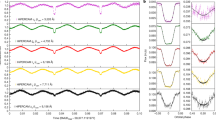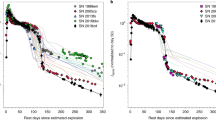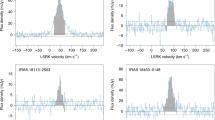Abstract
Stellar cores, that is, the central regions where densities and temperatures are high enough for nuclear fusion processes to take place, are usually covered by an opaque envelope. Only in very rare cases, stars may expose their cores, for example, when a tiny fraction of them evolve into Wolf–Rayet or helium hot subdwarf stars. However, for the vast majority of stars, namely unevolved stars that burn hydrogen into helium in their centres, direct observational clues on the cores are still missing. On the basis of a spectroscopic and photometric analyses, here we show that the bright B-type-star γ Columbae is the stripped pulsating core (with a mass of 4–5 M⊙, where M⊙ is the mass of the Sun) of a previously much more massive star of roughly 12 M⊙ that just finished central hydrogen fusion. The discovery of this star, which is still in a short-lived post-stripping structural re-adjustment phase, paves the way to obtain invaluable insights into the physics of both single and binary stars with respect to nuclear astrophysics and common-envelope evolution. In particular, it provides observational constraints on the structure and evolution of stripped-envelope stars.
This is a preview of subscription content, access via your institution
Access options
Access Nature and 54 other Nature Portfolio journals
Get Nature+, our best-value online-access subscription
$29.99 / 30 days
cancel any time
Subscribe to this journal
Receive 12 digital issues and online access to articles
$119.00 per year
only $9.92 per issue
Buy this article
- Purchase on Springer Link
- Instant access to full article PDF
Prices may be subject to local taxes which are calculated during checkout




Similar content being viewed by others
Data availability
The astrometric, photometric and spectroscopic data used in this work are all publicly available via the cited sources.
Code availability
All codes/routines used in this work are publicly documented, but not publicly available.
References
Telting, J. H. et al. A high-resolution spectroscopy survey of β Cephei pulsations in bright stars. Astron. Astrophys. 452, 945–953 (2006).
Hubrig, S. et al. New magnetic field measurements of β Cephei stars and slowly pulsating B stars. Astron. Nachr. 330, 317–329 (2009).
Bagnulo, S., Landstreet, J. D., Fossati, L. & Kochukhov, O. Magnetic field measurements and their uncertainties: the FORS1 legacy. Astron. Astrophys. 538, A129 (2012).
von Weizsäcker, C. F. Über Elementumwandlungen im Innern der Sterne II. Phys. Z. 39, 633–646 (1938).
Bethe, H. A. Energy production in stars. Phys. Rev. 55, 434–456 (1939).
Przybilla, N., Firnstein, M., Nieva, M. F., Meynet, G. & Maeder, A. Mixing of CNO-cycled matter in massive stars. Astron. Astrophys. 517, A38 (2010).
Maeder, A. et al. Evolution of surface CNO abundances in massive stars. Astron. Astrophys. 565, A39 (2014).
Martins, F. et al. The MiMeS survey of magnetism in massive stars: CNO surface abundances of Galactic O stars. Astron. Astrophys. 575, A34 (2015).
Song, H. F., Meynet, G., Maeder, A., Ekström, S. & Eggenberger, P. Massive star evolution in close binaries. Conditions for homogeneous chemical evolution. Astron. Astrophys. 585, A120 (2016).
Walborn, N. R. On the existence of OB Stars with anomalous nitrogen and carbon spectra. Astrophys. J. 164, L67 (1971).
Martins, F. et al. Surface abundances of ON stars. Astron. Astrophys. 578, A109 (2015).
Herald, J. E., Hillier, D. J. & Schulte-Ladbeck, R. E. Tailored analyses of the WN 8 stars WR 40 and WR 16. Astron. J. 548, 932–952 (2001).
Heber, U. Hot subluminous stars. Publ. Astron. Soc. Pac. 128, 082001 (2016).
Götberg, Y., de Mink, S. E. & Groh, J. H. Ionizing spectra of stars that lose their envelope through interaction with a binary companion: role of metallicity. Astron. Astrophys. 608, A11 (2017).
Götberg, Y. et al. Spectral models for binary products: unifying subdwarfs and Wolf–Rayet stars as a sequence of stripped-envelope stars. Astron. Astrophys. 615, A78 (2018).
Ivanova, N. Common envelope: on the mass and the fate of the remnant. Astron. J. 730, 76 (2011).
Sana, H. et al. Binary interaction dominates the evolution of massive stars. Science 337, 444 (2012).
Crowther, P. A. Physical properties of Wolf–Rayet stars. Annu. Rev. Astron. Astrophys. 45, 177–219 (2007).
Groh, J. H., Oliveira, A. S. & Steiner, J. E. The qWR star HD 45166. II. Fundamental stellar parameters and evidence of a latitude-dependent wind. Astron. Astrophys. 485, 245–256 (2008).
Liu, J. et al. A wide star-black-hole binary system from radial-velocity measurements. Nature 575, 618–621 (2019).
Rivinius, T., Baade, D., Hadrava, P., Heida, M. & Klement, R. A naked-eye triple system with a nonaccreting black hole in the inner binary. Astron. Astrophys. 637, L3 (2020).
Lennon, D. J. et al. Gaia DR2 reveals a very massive runaway star ejected from R136. Astron. Astrophys. 619, A78 (2018).
El-Badry, K. & Quataert, E. A stripped-companion origin for Be stars: clues from the putative black holes HR 6819 and LB-1. Mon. Not. R. Astron. Soc. 502, 3436–3455 (2021).
Dessart, L., Hillier, D. J., Li, C. & Woosley, S. On the nature of supernovae Ib and Ic. Mon. Not. R. Astron. Soc. 424, 2139–2159 (2012).
Wright, E. L. et al. The Wide-field Infrared Survey Explorer (WISE): mission description and initial on-orbit performance. Astron. J. 140, 1868–1881 (2010).
Kimeswenger, S. et al. YY Hya and its interstellar environment. Astron. Astrophys. 656, A145 (2021).
Fedurco, M., Paunzen, E., Hümmerich, S., Bernhard, K. & Parimucha, Š. Pulsational properties of ten new slowly pulsating B stars. Astron. Astrophys. 633, A122 (2020).
Pedersen, M. G. et al. Internal mixing of rotating stars inferred from dipole gravity modes. Nat. Astron. 5, 715–722 (2021).
Southworth, J. & Bowman, D. M. High-mass pulsators in eclipsing binaries observed using TESS. Mon. Not. R. Astron. Soc. 513, 3191–3209 (2022).
Woosley, S. E. The evolution of massive helium stars, including mass loss. Astron. J. 878, 49 (2019).
Morel, M. & Magnenat, P. UBVRIJKLMNH photoelectric photometric catalogue. (Magnetic tape). Astron. Astrophys. Suppl. Ser. 34, 477 (1978).
Rufener, F. VizieR Online Data Catalog: Observations in the Geneva Photometric System 4. VizieR Online Data CatalogII/169/ https://ui.adsabs.harvard.edu/abs/1999yCat.2169....0R/abstract (1999).
Høg, E. et al. The Tycho-2 catalogue of the 2.5 million brightest stars. Astron. Astrophys. 355, L27–L30 (2000).
Mermilliod, J. C. VizieR Online Data Catalog: Homogeneous Means in the UBV System. VizieR Online Data CatalogII/168 https://ui.adsabs.harvard.edu/abs/2006yCat.2168....0M/abstract (2006).
van Leeuwen, F. Validation of the new Hipparcos reduction. Astron. Astrophys. 474, 653–664 (2007).
Cutri, R. M. et al. VizieR Online Data Catalog: AllWISE Data Release. VizieR Online Data CatalogII/328 https://ui.adsabs.harvard.edu/abs/2014yCat.2328....0C/abstract (2014).
Paunzen, E. A new catalogue of Strömgren–Crawford uvbyβ photometry. Astron. Astrophys. 580, A23 (2015).
Riello, M. et al. Gaia Early Data Release 3. Photometric content and validation. Astron. Astrophys. 649, A3 (2021).
Kurucz, R. L. in Model Atmospheres and Spectrum Synthesis (eds Adelman, S. J. et al.) 160–164 (ASP, 1996).
Irrgang, A., Kreuzer, S., Heber, U. & Brown, W. A quantitative spectral analysis of 14 hypervelocity stars from the MMT survey. Astron. Astrophys. 615, L5 (2018).
Fitzpatrick, E. L., Massa, D., Gordon, K. D., Bohlin, R. & Clayton, G. C. An analysis of the shapes of interstellar extinction curves. VII. Milky Way spectrophotometric optical-through-ultraviolet extinction and its R-dependence. Astron. J. 886, 108 (2019).
Waelkens, C. Slowly pulsating B stars. Astron. Astrophys. 246, 453–468 (1991).
Ricker, G. R. et al. Transiting Exoplanet Survey Satellite (TESS). J. Astron. Telesc. Instrum. Syst. 1, 014003 (2015).
Houck, J. C. & Denicola, L. A. ISIS: an interactive spectral interpretation system for high resolution X-ray spectroscopy. In Astronomical Data Analysis Software and Systems IX, ASP Conference Proc. Vol. 216 (eds Manset, N. et al.) 591–594 (ASP, 2000).
Moravveji, E. The impact of enhanced iron opacity on massive star pulsations: updated instability strips. Mon. Not. R. Astron. Soc. 455, L67–L71 (2016).
Dziembowski, W. A., Moskalik, P. & Pamyatnykh, A. A. The opacity mechanism in B-type stars—II. excitation of high-order g-modes in main-sequence stars. Mon. Not. R. Astron. Soc. 265, 588–600 (1993).
The Hipparcos and Tycho Catalogues ESA SP, 1200 (ESA, 1997).
De Cat, P. Observational asteroseismology of slowly pulsating B stars. Commun. Asteroseismol. 150, 167 (2007).
Schrijvers, C., Telting, J. H., Aerts, C., Ruymaekers, E. & Henrichs, H. F. Line-profile variations due to adiabatic non-radial pulsations in rotating stars. I. Observable characteristics of spheroidal modes. Astron. Astrophys. Suppl. Ser. 121, 343–368 (1997).
Briquet, M., De Cat, P., Aerts, C. & Scuflaire, R. The B-type variable HD 131120 modelled by rotational modulation. Astron. Astrophys. 380, 177–185 (2001).
Briquet, M. et al. He and Si surface inhomogeneities of four Bp variable stars. Astron. Astrophys. 413, 273–283 (2004).
Irrgang, A. et al. A new method for an objective, χ2-based spectroscopic analysis of early-type stars. First results from its application to single and binary B- and late O-type stars. Astron. Astrophys. 565, A63 (2014).
Giddings, J. R. An Investigation of the Optical and Ultraviolet Spectra of Hot Subdwarf Stars. PhD thesis, Univ. London (1981).
Butler, K. & Giddings, J. R. in Newsletter of Analysis of Astronomical Spectra No. 9 (Univ. London, 1985).
Hubeny, I., Hummer, D. G. & Lanz, T. NLTE model stellar atmospheres with line blanketing near the series limits. Astron. Astrophys. 282, 151–167 (1994).
Tremblay, P. E. & Bergeron, P. Spectroscopic analysis of DA white dwarfs: Stark broadening of hydrogen lines including nonideal effects. Astron. J. 696, 1755–1770 (2009).
Beauchamp, A., Wesemael, F. & Bergeron, P. Spectroscopic studies of DB white dwarfs: improved Stark profiles for optical transitions of neutral helium. Astrophys. J. Suppl. Ser. 108, 559–573 (1997).
Nieva, M.-F. & Przybilla, N. Present-day cosmic abundances. A comprehensive study of nearby early B-type stars and implications for stellar and Galactic evolution and interstellar dust models. Astron. Astrophys. 539, A143 (2012).
Georgy, C. et al. Populations of rotating stars. I. Models from 1.7 to 15 M⊙ at Z = 0.014, 0.006, and 0.002 with Ω/Ωcrit between 0 and 1. Astron. Astrophys. 553, A24 (2013).
Lindegren, L. Re-normalising the Astrometric Chi-square in Gaia DR2 GAIA-C3-TN-LU-LL-124 (DPAC, 2018); www.rssd.esa.int/doc_fetch.php?id=3757412
Nieva, M. F. & Simón-Díaz, S. The chemical composition of the Orion star forming region. III. C, N, Ne, Mg, and Fe abundances in B-type stars revisited. Astron. Astrophys. 532, A2 (2011).
Fossati, L. et al. B fields in OB stars (BOB): on the detection of weak magnetic fields in the two early B-type stars β CMa and ∈ CMa. Possible lack of a ‘magnetic desert’ in massive stars. Astron. Astrophys. 574, A20 (2015).
Ekström, S. et al. Grids of stellar models with rotation. I. Models from 0.8 to 120 M⊙ at solar metallicity (Z = 0.014). Astron. Astrophys. 537, A146 (2012).
Acknowledgements
G.M. thanks the Swiss National Science Foundation (project number 200020-205154). G.M. has received funding from the European Research Council (ERC) under the European Union’s Horizon 2020 research and innovation programme (grant agreement number 833925, project STAREX). We thank U. Heber and M. Sasaki for discussions and J. E. Davis for the development of the SLXFIG module that was used to prepare the figures in this paper. Based on data products from observations made with ESO Telescopes at the La Silla Paranal Observatory under programme IDs 080.D-0333(A), 182.D-0356(C), 088.A-9003(A) and 090.D-0358(A). Based on observations obtained at the Canada–France–Hawaii Telescope (CFHT), which is operated by the National Research Council of Canada, the Institut National des Sciences de l’Univers of the Centre National de la Recherche Scientique of France and the University of Hawaii. Funding for the TESS mission is provided by NASA’s Science Mission directorate. This paper includes data collected by the TESS mission, which are publicly available from the Mikulski Archive for Space Telescopes (MAST). Some of the data presented in this paper were obtained from MAST. STScI is operated by the Association of Universities for Research in Astronomy, Inc., under NASA contract NAS5-26555. This work has made use of data from the European Space Agency (ESA) mission Gaia (https://www.cosmos.esa.int/gaia), processed by the Gaia Data Processing and Analysis Consortium (DPAC; https://www.cosmos.esa.int/web/gaia/dpac/consortium). Funding for the DPAC has been provided by national institutions, in particular the institutions participating in the Gaia Multilateral Agreement. This publication makes use of data products from the Two Micron All Sky Survey, which is a joint project of the University of Massachusetts and the Infrared Processing and Analysis Center/California Institute of Technology, funded by the National Aeronautics and Space Administration and the National Science Foundation. This publication makes use of data products from the Wide-field Infrared Survey Explorer, which is a joint project of the University of California, Los Angeles, and the Jet Propulsion Laboratory/California Institute of Technology, funded by the National Aeronautics and Space Administration.
Author information
Authors and Affiliations
Contributions
All authors contributed to the work presented in this paper and to the writing of the manuscript. A.I. carried out the photometric, spectroscopic and astrometric analysis, the results of which were primarily interpreted by N.P. G.M. calculated the tailored stellar evolution model.
Corresponding author
Ethics declarations
Competing interests
The authors declare no competing interests.
Peer review
Peer review information
Nature Astronomy thanks the anonymous reviewers for their contribution to the peer review of this work.
Additional information
Publisher’s note Springer Nature remains neutral with regard to jurisdictional claims in published maps and institutional affiliations.
Supplementary information
Supplementary Information
Supplementary Figs. 1–9 and Tables 1–5.
Rights and permissions
Springer Nature or its licensor (e.g. a society or other partner) holds exclusive rights to this article under a publishing agreement with the author(s) or other rightsholder(s); author self-archiving of the accepted manuscript version of this article is solely governed by the terms of such publishing agreement and applicable law.
About this article
Cite this article
Irrgang, A., Przybilla, N. & Meynet, G. γ Columbae as a recently stripped pulsating core of a massive star. Nat Astron 6, 1414–1420 (2022). https://doi.org/10.1038/s41550-022-01809-6
Received:
Accepted:
Published:
Issue Date:
DOI: https://doi.org/10.1038/s41550-022-01809-6



